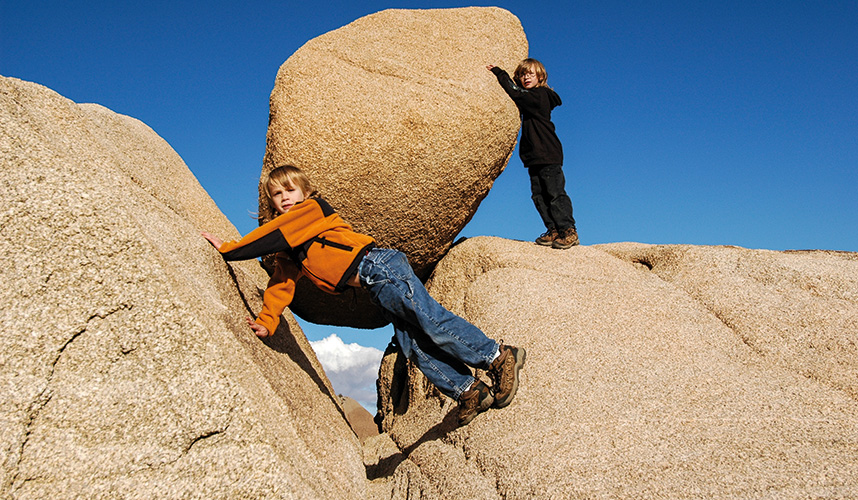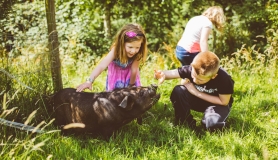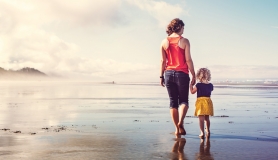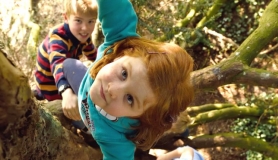- GO ON A MIDNIGHT HIKE - It’s a well known fact that staying up past bedtime is massively exciting. Plan a trip for later in the year when you can take a hike at night. Wait until nightfall and plan a short spooky walk on a route you know well on good paths. Take headtorches and a midnight feast. Make sure you stop, turn off the torches, stay quiet and open your eyes to the wonderful night skies and your ears to the sounds of the darkness.
- CYCLE WITH THE GHOST TRAINS - There is a growing network of traffic-free paths on dismantled railway lines across the country. They provide safe and often spectacular short rides. The beauty of cycling with younger kids is that you can walk at a decent adult pace while they ride and their bikes are also easy to fling into the car boot. Older kids will easily clock up a few miles but parents need to have their own bike to keep up. Go to sustrans.org.uk to find a traffic-free route near you.
- MASTER STICK WHITTLING - Whittling can really capture the imagination of children. If the wonderful word ‘whittle’ means nothing to you, it is simply carving a large stick. Go on a woodland walk to choose the perfect specimen and reach your whittling destination. Start off using a potato peeler scraping away from the body and downwards to remove the bark. Older children will relish the responsibility of progressing onto proper penknife whittling. The Woodland Trust’s website has more information on safe whittling for kids - woodlandtrust.org.uk
- GO BOULDERING - Another one to plan for later in the year. Kids of all ages love showing off their climbing moves. Set some ground rules and pick a place with smaller rocks and flat terrain where you can support from below. Encourage traversing challenges and finding different ways of getting up and down easy boulders. Families who really enjoy this activity may want to invest in a bouldering mat - you may then spend all of the summer holidays bouldering! Potential bouldering venues can be found by looking at the crag location map at ukclimbing.com
- HONE YOUR NAVIGATION - Let your children lead you on a hike and give them a head start on navigation. Pick an easy route that they’ve never done before with a clear objective such as a summit and give them some tips on using a map to get there. Lots of praise and subtle ‘clues’ when they veer off course should inspire them to become a mountain leader of the future.
- SCALE A MOUNTAIN - Perhaps best to save for later but a great one to plan for, as it may need a little more planning. Your child’s mountaineering abilities may well surprise you. Some children who can’t be coaxed to walk half a mile to school will spring into life when faced with an uphill expedition, especially if they have to use their hands to scramble up rocky paths. Pick a place with an interesting summit and be realistic and flexible – it doesn’t matter if you don’t get all the way up!
- GO ON A FISHING EXPEDITION - Serious fishing requires permits and equipment, but a net and bucket will do for an expedition to fish the shallow waters of the local stream or beck. If it’s safe to do so, get in and walk upstream, fishing as you go. When you reach a beach or grassy bank, check out who has netted the best catch. Take a nature spotting book and magnifying glass to identify what’s in your bucket. Be sure to put your catch back after observation.
- GO HIGH ALTITUDE KITE FLYING - Kites can provide a good incentive to walk into the hills. Pick a hill or mountain to go up and see if you can be the highest kite flyer around. Kites are light enough to take anywhere and even very young children can join in. By getting up high, there’s usually enough breeze for a kite to take flight and there are fewer things to restrict you. Pocket kites without poles are the most packable.
- FIND FUEL AND GET COOKING - Go on a ‘chumping’ hike in a wooded area to find dead wood from six different types of trees to use as kindling. Children very rarely get a chance to start their own fires, but the countryside is not the place to do this. Take your kindling back home to make your fire in your garden. See if the children can use their kindling to get the fire going themselves. Teach them how to use matches, spills and tongs safely or get a flint to really spark their imaginations. Corn-on-the-cob, marshmallows and jacket potatoes cooked in foil are all tried and tested fiery foods that you could cook on your fire.
- GO TREE-CLIMBING - Make sure that the primal art of tree-climbing is not lost to the next generation. Pick a walk with some wooded areas and tell your kids they are going tree-climbing. Once you start looking, it’s easy to spot suitable trees for children of any age. Most kids are remarkably self-limiting and can learn to assess risk and descend what they have climbed with a safe pair of hands beneath them. The textures, smells and sounds of the trees make for a cool sensory experience.
Rachel is an outdoors all-rounder who loves hiking and biking, scrambling and climbing. In 2007 she became the first woman to reach the summit of every country in Europe and co-wrote Cicerone guide book Europe’s High Points soon after. She is passionate about encouraging the next generation of climbers and explorers.
MORE INSPIRATION
READ More of Rachel’s work at cicerone.co.uk/authors/rachel-crolla
PLAY Get downloadable resources at woodlandtrust.org.uk/naturedetectives/activities







